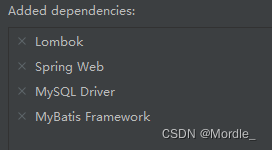目录
一.简介
tkMapper就是一个MyBatis插件,提高开发效率。
- 提供了针对单表的数据库操作方法
- 逆向工程(根据数据表生成实体类、dao接口、映射文件)
二.tkMapper整合
2.1 基于SpringBoot完成MyBatis的整合
1.新建SpringBoot项目
2.添加需要的依赖

3.配置properties
spring.datasource.driver-class-name=com.mysql.jdbc.Driver
spring.datasource.url=jdbc:mysql://localhost:3306/fmmall2?useSSL=false&userUnicode=true&characterEncoding=utf-8&serverTimeZone=GMT
spring.datasource.username=root
spring.datasource.password=####
mybatis.type-aliases-package=com.mordle.tkmapperdemo.beans
mybatis.mapper-locations=classpath:mappers/*Mapper.xml
4.在启动类添加@MapperScan(“com.mordle.tkmapperdemo.dao”)
2.2整合tkMapper
1.添加tkMapper的依赖
<dependency>
<groupId>tk.mybatis</groupId>
<artifactId>mapper-spring-boot-starter</artifactId>
<version>4.2.1</version>
</dependency>
2.修改启动类@MapperScan(“com.mordle.tkmapperdemo.dao”)注解的包路径
import tk.mybatis.spring.annotation.MapperScan;
三.tkMapper使用
1.创建数据表
2.创建实体类
@Data
@AllArgsConstructor
@NoArgsConstructor
@Table(name = "category")
public class Category {
@Id
private Integer categoryId;
private String categoryName;
private Integer categoryLevel;
private Integer parentId;
private String categoryIcon;
private String categorySlogan;
private String categoryPic;
private String categoryBgColor;
}
3.创建GeneralDao包不被@MapperScan扫描到,定义模板,并不是具体的操作。

public interface GeneralDao<T> extends Mapper<T>, MySqlMapper<T> {
}
4.创建DAO接口
@Mapper
public interface CategoryDao extends GeneralDao<Category> {
//tkMapper已经完成了对单表的通用操作的封装,自定义Dao接口继承即可
}
四.TkMapper提供的方法
4.1添加
@Test
public void testInsert(){
Category category = new Category(0,"测试2",2,0,"2.png","02.png","heh","black");
//方法一:int i = categoryDao.insert(category);
//方法二:回显id,必须在实体类添加@Id
int i = categoryDao.insertUseGeneratedKeys(category);
System.out.println(category.getCategoryId());
assertEquals(1,i);//返回值和期望值是否相等
}
4.2更新
@Test
public void testUpdate(){
Category category = new Category(48,"测试3",3,0,"3.png","02.png","heh","black");
//方法一:实体类必须要有@Id
int i = categoryDao.updateByPrimaryKey(category);
//方法二:根据自定义条件修改,Example 就是封装条件的
//int i1 = categoryDao.updateByExample(Example example);
assertEquals(1,i);
}
4.3删除
@Test
public void testDelete(){
//方法一:实体类必须要有@Id
int i = categoryDao.deleteByPrimaryKey(48);
//方法二:根据自定义条件删除,Example 就是封装条件的
//int i1 = categoryDao.deleteByExample(Example example);
assertEquals(1,i);
}
4.4查询
方法一:查询所有
@Test
public void testSelect1(){
List<Category> categories = categoryDao.selectAll();
for (Category category : categories) {
System.out.println(category);
}
方法二:根据主键查询实体类要有@Id
@Test
public void testSelect2(){
Category category1 = categoryDao.selectByPrimaryKey(49);
System.out.println(category1);
}
方法三:按条件查询
@Test
public void testSelect3(){
//1.创建一个Example封装类别Category查询条件
Example example = new Example(Category.class);
Example.Criteria criteria = example.createCriteria();
//2.按条件查询等级为1或2的商品,不能是and,有逻辑关联 //不等于1 andNotEqualTo
criteria.andEqualTo("categoryLevel",1);
criteria.orEqualTo("categoryLevel",2);
//3.模糊查询
criteria.andLike("categoryName","%干%");
List<Category> categories = categoryDao.selectByExample(example);
for (Category category : categories) {
System.out.println(category);
}
}
方法四:分页查询
//第1页:1 ~10,第2页:11~20
@Test
public void testSelect4(){
int pageNum=2;
int pageSize=10;
int start=(pageNum-1)*pageSize;
RowBounds rowBounds = new RowBounds(start,pageSize);
List<Category> categories = categoryDao.selectByRowBounds(new Category(), rowBounds);
for (Category category : categories) {
System.out.println(category);
}
//查询总记录数
int i = categoryDao.selectCount(new Category());
System.out.println(i);
}
方法五:条件分页
@Test
public void testSelect5(){
Example example = new Example(Category.class);
Example.Criteria criteria = example.createCriteria();
//2.按条件对一级类别分页
criteria.andEqualTo("categoryLevel",1);
int pageNum=1;
int pageSize=3;
int start=(pageNum-1)*pageSize;
RowBounds rowBounds = new RowBounds(start,pageSize);
List<Category> categories = categoryDao.selectByExampleAndRowBounds(example, rowBounds);
for (Category category : categories) {
System.out.println(category);
}
//查询满足条件的记录数
int i = categoryDao.selectCountByExample(example);
System.out.println(i);
}
4.5连表查询
根据用户查询订单
//用户表
@Data
@NoArgsConstructor
@AllArgsConstructor
@Table(name = "users")
public class User {
@Id
private Integer userId;
private String username;
private String password;
private String nickname;
private String realname;
private String userImg;
private String userMobile;
private String userEmail;
private String userSex;
private Date userBirth;
private Date userRegtime;
private Date userModtime;
//订单
private List<Order> orderList;
}
//订单表
@Data
@NoArgsConstructor
@AllArgsConstructor
@Table(name = "orders")
public class Order {
@Id
private String orderId;
//用户Id
private Integer userId;
private String receiverName;
private String receiverMobile;
private String receiverAddress;
}
方法一:多次单表查询
@Test
public void testSelect(){
//查询用户的同时查询订单
Example example = new Example(User.class );
Example.Criteria criteria = example.createCriteria();
criteria.andEqualTo("username","zhangsan");
//根据用户名查询用户
//1.先根据用户名查询用户信息
List<User> users = userDao.selectByExample(example);
User user = users.get(0);
//2.再根据用户id到订单表查询
Example example1 = new Example(Order.class);
Example.Criteria criteria1 = example1.createCriteria();
criteria.andEqualTo("userId",user.getUserId());
List<Order> orderList = orderDao.selectByExample(example1);
//3.将查询到订单集合设置到user
user.setOrderList(orderList);
System.out.println(user);
}
方法二:自定义方法,通过mapper.xml
@Mapper
public interface UserDao extends GeneralDao<User> {
public User selectByUsername(String username);
}
<?xml version="1.0" encoding="UTF-8"?>
<!DOCTYPE mapper
PUBLIC "-//mybatis.org//DTD Config 3.0//EN"
"http://mybatis.org/dtd/mybatis-3-mapper.dtd">
<mapper namespace="com.mordle.tkmapperdemo.dao.UserDao">
<resultMap id="userMap" type="User">
<id column="user_id" property="userId"/>
<result column="username" property="username"/>
<result column="password" property="password"/>
<result column="nickname" property="nickname"/>
<result column="realname" property="realname"/>
<result column="user_img" property="userImg"/>
<result column="user_mobil" property="userMobil"/>
<result column="user_email" property="userEmail"/>
<result column="user_sex" property="userSex"/>
<result column="user_birth" property="userBirth"/>
<result column="user_regtime" property="userRegtime"/>
<result column="user_modtime" property="userModtime"/>
<collection property="orderList" ofType="order">
<result column="order_id" property="orderId"/>
<result column="receiver_name" property="receiverName"/>
<result column="receiver_mobile" property="receiverMobile"/>
<result column="receiver_address" property="receiverAddress"/>
</collection>
</resultMap>
<select id="selectByUsername" resultMap="userMap">
select u.*,o.user_id,o.receiver_name,o.receiver_address,o.receiver_mobile
from fmmall2.users u inner join fmmall2.orders o
where u.user_id=o.user_id
</select>
</mapper>






















 905
905

 被折叠的 条评论
为什么被折叠?
被折叠的 条评论
为什么被折叠?








